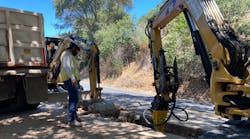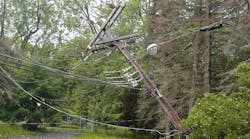PG&E Submits 2026-2028 Wildfire Mitigation Plan
Pacific Gas and Electric Company (PG&E) has submitted PG&E's 2026-2028 Wildfire Mitigation Plan (WMP), which is built on risk-informed safety actions that prevented major wildfires in 2023 and 2024 to California's Office of Energy Infrastructure Safety (Energy Safety).
The plan has provided details of the company's actions to construct, maintain and operate its system to minimize the risk of catastrophic wildfires and help keep its customers and hometowns safe. The plan integrates tools and solutions including inspecting assets with drones, using artificial intelligence to improve weather forecasts and installing sensors to detect vibrations, sounds and light to indicate potential anomalies on an electric circuit leading to an ignition.
The plan highlights layers of protection to reduce wildfire ignition risk and strengthen PG&E's electric grid in Northern and Central California locations where risk is most severe. The measures include strengthening 570 miles of overhead powerlines and poles; adding nearly 1,100 more miles of powerlines underground; using drones for a perfect view of electric assets; benefitting from a mature network of weather station and high-definition cameras with AI; trimming trees and more.
During wildfire risk, the efforts are encouraged with Enhanced Powerline Safety Settings (EPSS), and Public Safety Power Shutoffs (PSPS) to protect customers.
The WMP has introduced new technology solutions, including the following:
- Gridscope devices. Gridscope pilot deployment started in 2023 and expanded in 2024 with more than 10,000 Gridscope devices now in use across 900 circuit miles (or approximately 3.5% of miles in areas with the highest fire risk) These pole-mounted sensors detect vibrations, sounds and light to indicate potential anomalies leading to an ignition.
- Early Fault Detection (EFD). It is the power grid's version of the check-engine light in a car. Due to PG&E's new radio frequency (RF) monitoring technology, a growing network of EFD sensors on power poles provide a comprehensive understanding of emerging equipment hazards such as damaged conductor strands or vegetation encroachment that would otherwise be challenging to detect. Promising early results have led PG&E to consider expanding deployment of advanced RF technology. These purposeful investments in technology will change the paradigm of utility asset management.
- Aerial Span Inspections. This new inspection tool gets added eyes-on-risk on equipment in areas of extreme wildfire risk. Leveraging aerial inspections in 2024 (220,000 poles) and 2025, the span inspections will entail a review of a streamlined, specialized set of photos tailored to identify conditions on equipment that pose the highest risk, including locations mid-span (between poles). These inspections will be conducted in the middle of the established three-year inspection cycle and be piloted in 2026-2028.
The WMP highlighted layers of protection found effective in reducing wildfire risk. Using these tools, no major wildfires resulted from the company's equipment in 2023 and 2024.
- Undergrounding powerlines in high fire-risk areas reduced the ignition risk from overhead electric distribution lines. PG&E plans to underground 1,077 miles of powerlines between 2026 and 2028.
- Overhead System Upgrades such as installing covered conductor, strengthened poles, and wider crossarms will provide long-term ignition risk reduction by improving the grid’s construction and operation. The WMP calls for making these overhead upgrades across 190 circuit miles each year of 2026, 2027 and 2028, resulting in 570 miles over three years.
- Enhanced Powerline Safety Settings protect 1.8 million PG&E customers living and working in areas with elevated or extreme wildfire risk. In 2024, these settings contributed to more than 72% reduction in California Public Utilities Commission-reportable ignitions when enabled on primary distribution lines, compared to the 2018-2020 average. More than half of customers protected by EPSS did not experience a power outage while EPSS was enabled in 2024.
Through the end of 2024, the average duration of outages on an EPSS-enabled circuit decreased 17% from the prior two-year average. PG&E will also install additional sectionalizing devices and animal/avian protection equipment to further reduce the impact of EPSS outages.
- Vegetation Management programs help reduce both outages and potential ignitions caused by vegetation contacting PG&E's equipment.
- Inspections and Repair Efforts are informed by risk models and are part of comprehensive monitoring and data collection programs providing insight into changing environmental hazards around assets to inform mitigation actions.
- Situational Awareness Improvements include enabling artificial intelligence to process wildfire camera data and provide automated wildfire notifications. PG&E will continue using weather forecasting and a comprehensive monitoring and data collection network using high-definition wildfire cameras and weather stations to help detect, prevent, and respond to the risk of wildfires.
- Public Safety Power Shutoffs are a last resort during extreme weather conditions to reduce the risk of catastrophic fire. PG&E's experienced meteorologists use weather models to forecast risk on a granular basis and factor in vegetation in proximity to overhead electrical lines. Recently, PG&E's use of PSPS has evolved and been refined in terms of the size and duration of events. In 2023, three PSPS outages affected 5,000 customers. With 2024's more severe weather, PG&E initiated six PSPS events protecting 50,000 customers in 23 counties.


